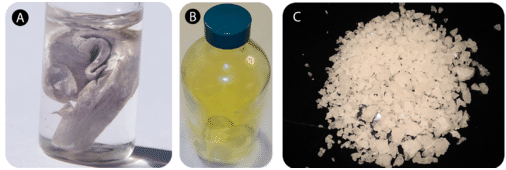2.12: Compounds
- Page ID
- 52542
What do you need to start building a house?
Houses take on a variety of shapes. Some are large mansions while others are simpler dwellings. No matter what the house looks like there will be certain common components – wood, brick, plaster, nails, plumbing, wiring, etc. These components go together in numerous ways to make up the unique final product.
Compounds in chemistry are composed of different types and numbers of atoms. But atoms are common building blocks for a wide variety of compounds, just as brick, wood, and other materials are common building blocks for many types of houses.
Compounds
A compound is a substance that contains two or more elements chemically combined in a fixed proportion. The elements carbon and hydrogen combine to form many different compounds. One of the simplest is called methane, in which there are always four times as many hydrogen particles as carbon particles. Methane is a pure substance because it always has the same composition. However, it is not an element because it can be broken down into simpler substances—carbon and hydrogen.
Recall that the components of a mixture can be separated from one another by physical means. This is not true for a compound. Table salt is a compound consisting of equal parts of the elements sodium and chlorine. Salt cannot be separated into its two elements by filtering, distillation, or any other physical process. Salt and other compounds can only be decomposed into their elements by a chemical process. A chemical change is a change that produces matter with a different composition. Many compounds can be decomposed into their elements by heating. When sugar is heated, it decomposes into carbon and water. Water is still a compound, but one which cannot be broken down into hydrogen and oxygen by heating. Instead, the passage of an electrical current through water will produce hydrogen and oxygen gases.
The properties of compounds are generally very different than the properties of the elements from which the compound is formed. Sodium is an extremely reactive soft metal that cannot be exposed to air or water. Chlorine is a deadly gas. The compound sodium chloride is a white solid which is essential for all living things (see below).

July Fourth: A day for picnics, parades and chemistry. In this video by Science Friday, Professor Bassam Shakhashiri explains some of the science of fireworks.
Summary
- A compound is a substance that contains two or more elements chemically combined in a fixed proportion.
- A chemical change is a change that produces matter with a different composition.
Review
- What is a compound?
- How is a compound different from an element?
- What is a chemical change?
Explore More
Use the resource below to answer the following questions.
- What lists all the elements we know about?
- What compound is made of two hydrogen atoms and one oxygen atom?
- What compound is made of one carbon atom and two oxygen atoms?

